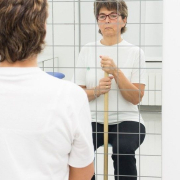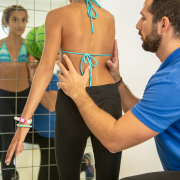Can bracing improve trunk asymmetries in young adults?
Scoliosis is a condition characterised by the presence of a vertebral deformity in the three planes of space. The extent to which this deformity is visible externally varies from case to case. As stated in the guidelines recently developed by SOSORT, one of the primary objectives of scoliosis rehabilitation treatment is to improve trunk asymmetries. Achieving this objective has important implications for quality of life — after all, having a positive self-image helps to ensure a good level of psychological wellbeing and this, in turn, translates into a better quality of life.
Not uncommonly, adolescents with scoliosis lack the willpower or motivation to undertake bracing treatment, or perhaps have never had a medical specialist recommend it to them; others, quite simply, may not even have realised that they had scoliosis.
Basically, many different factors can affect what scoliosis treatment a person received, or did not receive, in adolescence. But the fact is that some people reach adulthood before realising, for example, that they have one waist straighter than the other, that part of their rib cage protrudes, or that one breast is higher than the other.
What can be done to improve these asymmetries?
“Although there is no scientific evidence available to help us answer this question with precision, we at ISICO have performed some bracing treatments in young adults (up to 25 years of age) – explains dr Fabio Zaina, physiatrist – In such cases, our doctors, during the consultation, are clear from the outset: this is a long and demanding course of treatment. For the first few months, the brace should be worn full time, i.e., for 23 hours a day, after which the brace-wearing time is reduced very gradually in an effort to maintain the results obtained”.
Patients wanting to start bracing must be absolutely convinced about it and highly motivated, too, because any sudden interruption of the treatment, without respecting the abovementioned weaning-off phase, can negatively affect the stability of the spine.
On the subject of stability, we should also point out that bracing treatment must always be combined with specific exercises based on self-correction. The purpose of these exercises is to keep the back muscles strong and teach the patient how to keep their trunk correctly positioned during the various activities of daily life.
Can adults obtain a radiographic improvement?
Unfortunately, radiographic improvements cannot be achieved in adulthood. In individuals who have reached full skeletal maturity, bracing is never proposed with this aim in mind.
In other words, bracing in adults can improve the external asymmetries related to the scoliotic curves, but it cannot reduce the Cobb degrees of the curves themselves.
Are there no other options available for adults who are reluctant to wear a brace?
“Adults can always follow a specific physiotherapy programme based on self-correction exercises – explains Valentina Premoli, physiotherapist- These exercises are a way to act on the postural component of scoliosis. They serve to counteract the spine’s tendency to collapse to one side, and can thus improve the functioning of the back generally. This type of treatment helps to limit the worsening of the asymmetries that accompanies the spine’s tendency to give way in the direction of the curves — a tendency that becomes increasingly marked as we get older”.





